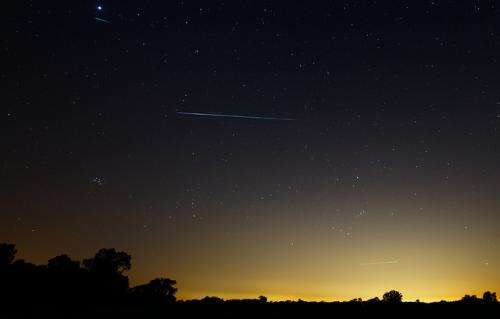Orionids, planets, constellations brighten October skies

The 2012 Orionid meteor shower peaks on the night of Oct. 20-21, and that night's almost-new moon favors a good show. The moon's absence from the pre-dawn sky during the Orionids' peak also means that bright moonlight won't be a problem.
In addition to Orionids, you'll see brilliant Venus, red Mars, the dog star Sirius and bright winter constellations such as Orion, Gemini and Taurus. Even if you don't spy a meteor, the rest of the sky is dynamite!
Set your alarm, brew some hot chocolate and plan to enjoy the show with NASA astronomer Bill Cooke and his team from NASA's Marshall Space Flight Center. They'll be answering your questions via live Web chat on Saturday, Oct. 20 from 11 p.m. to 3 a.m. EDT.
Convert to your local time using this online tool.
Joining the chat is easy. Simply return to this chat page a few minutes before 11 p.m. EDT on Saturday, Oct. 20. The chat module will appear at the bottom of this page. Type your name to join the chat, then we'll start taking your questions at 11 p.m. EDT.
Watch the Orionids! Live Ustream Feed
A live Ustream video feed of the Orionid meteor shower will be embedded below on the night of the chat. The camera is mounted at NASA's Marshall Space Flight Center in Huntsville, Ala. During the day, you'll see a dark gray box—the camera is light-activated and will turn on at dusk each evening. At night you'll see white points, or stars, on a black background.
More About the Orionids
Orionids appear every year around this time when Earth orbits through an area of space littered with debris from the ancient comet. Normally, the shower produces 20 or so meteors per hour. The past few years, however, have been much better than usual.
"Earth is passing through a stream of debris from Halley's Comet, the source of the Orionids," says Bill Cooke of NASA's Meteoroid Environment Office. "Flakes of comet dust hitting the atmosphere should give us dozens of meteors per hour."
The best time to look is before sunrise on Sunday, Oct. 21. That's when Earth encounters the most dense part of Halley's debris stream. Observing is easy: Wake up a few hours before dawn, go outside and look up. No telescope is required to see Orionids shooting across the sky.
"Since 2006, the Orionids have been one of the best showers of the year, with counts of 60 or more meteors per hour," says Cooke.
Provided by NASA




















